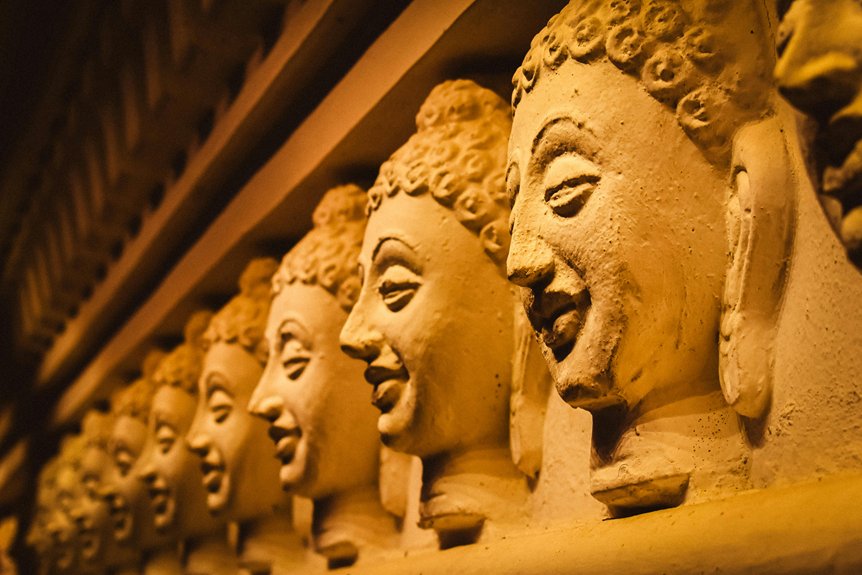You’ll discover Cyprus’s most enchanting Orthodox Christmas heritage sites across its diverse landscapes. From the Troodos Mountains’ centuries-old monasteries to Nicosia’s Byzantine churches, Larnaca’s Saint Lazarus Church, Paphos’s archaeological wonders, and Limassol’s spiritual landmarks, each destination offers a profound glimpse into Mediterranean Christian traditions. These sacred spaces will transport you through time, revealing intricate frescoes, architectural marvels, and living religious practices that whisper centuries of spiritual devotion.
Wichtigste Erkenntnisse
- Kykkos Monastery in Troodos Mountains: A magnificent 11th-century Orthodox sanctuary showcasing centuries of religious traditions and stunning Byzantine architectural heritage.
- Saint Lazarus Church in Larnaca: An extraordinary 9th-century sacred site housing Lazarus’s tomb and featuring rich Orthodox Christmas liturgical celebrations.
- Agia Sophia Church in Nicosia: An iconic Byzantine architectural marvel representing centuries of Orthodox Christian spiritual and cultural preservation.
- Monastery of Agios Nikolaos tis Stegis: A remarkable Byzantine monastery in Limassol renowned for its exquisite frescoes and deep religious significance.
- Chrysopolitissa Basilica in Paphos: An archaeological treasure revealing early Christian traditions through intricate mosaics and sacred architectural elements.
Troodos Mountains: Centuries-Old Monasteries and Painted Churches
Nestled in the heart of Cyprus, the Troodos Mountains harbor nine remarkable Byzantine churches that represent an extraordinary witness to medieval Orthodox Christian heritage. When exploring these cyprus orthodox christmas tradition sites, you’ll discover a breathtaking landscape where centuries-old monasteries and painted churches reveal profound spiritual narratives.
The UNESCO World Heritage sites within this region showcase exquisite frescoes and mosaics that illuminate Byzantine artistic traditions. You’ll be captivated by the Kykkos Monastery, founded in the 11th century, which stands as a manifestation of Orthodox architectural and religious preservation. Each church’s vibrant interior walls and intricate ceiling murals offer intimate glimpses into medieval religious practices and cultural expressions.
These historic structures aren’t mere museum pieces-many remain active places of worship, allowing visitors to experience living religious traditions. The Troodos Mountains’ sacred sites provide an unparalleled opportunity to connect with Cyprus’s rich Orthodox Christian heritage, inviting deep reflection on spiritual continuity and artistic excellence.
Nicosia’s Architectural Gems: Byzantine Churches and Religious Heritage
While exploring the cultural heart of Cyprus, travelers will discover Nicosia’s profound Byzantine architectural heritage through its remarkable collection of historic churches. These architectural treasures offer deep insights into the island’s Orthodox Christian traditions and rich cultural legacy.
| Church Name | Century | Architektonischer Stil |
|---|---|---|
| Agia Sophia | 11th | Byzantine |
| Phaneromeni | 18th | Traditional |
| Saint John Cathedral | 14th | Gothic-Byzantine |
| Local Parish Churches | Various | Mixed Influences |
The Church of Agia Sophia stands as a prime example, featuring exquisite 11th-century Byzantine architecture and meticulously preserved frescoes. You’ll be captivated by the Phaneromeni Church’s distinctive bell tower and intricate iconostasis, which reflect centuries of religious craftsmanship. The Saint John Cathedral further demonstrates the architectural complexity, blending Gothic elements with traditional Byzantine design.
Each church serves as a living museum, narrating Cyprus’ spiritual journey through stunning architectural details and sacred artistic expressions. Visitors can immerse themselves in these sacred spaces, experiencing the profound religious heritage that has shaped Nicosia’s cultural landscape.
Larnaca’s Sacred Sites: Saint Lazarus Church and Orthodox Traditions
From Nicosia’s Byzantine architectural wonders, travelers can journey eastward to Larnaca, where the Saint Lazarus Church stands as a profound manifestation to Orthodox Christian heritage. You’ll discover a remarkable religious site originally constructed in the 9th century, housing the revered tomb of Lazarus, whom Jesus is said to have resurrected.
The church’s architectural design offers a compelling narrative of spiritual history, blending Byzantine, Gothic, and Baroque elements that reflect the region’s complex religious evolution. When you visit, you’ll experience rich Orthodox traditions, including intricate icons and annual celebrations like the Feast of Saint Lazarus on March 17.
Pilgrims and cultural enthusiasts will appreciate the church’s deep spiritual significance. Its carefully preserved structure and sacred artifacts provide intimate insights into Cyprus’s religious practices, offering visitors a profound connection to centuries of Orthodox Christian traditions and spiritual devotion.
Paphos Archaeological Wonders: Early Christian Basilicas and Mosaics
As archaeological treasures unfold across Cyprus, Paphos emerges as a compelling chronicle to early Christian heritage, inviting travelers to explore its remarkable basilicas and mosaic-adorned sites. You’ll discover the Basilica of Chrysopolitissa, a monumental site featuring intricate mosaic floors that capture geometric patterns and mythological narratives from the 4th-6th centuries AD.
The House of Dionysos beckons with its extraordinarily preserved mosaic pavements, where scenes of Greek mythology come alive through stunning craftsmanship. You’ll be captivated by the detailed representations of Dionysos’s triumph, offering a vivid glimpse into ancient artistic expression.
At the UNESCO World Heritage Tombs of the Kings, you’ll encounter rock-cut hypogea showcasing Doric-style architecture and Christian catacombs adorned with evocative frescoes. These archaeological wonders provide an unparalleled window into the Mediterranean’s early Christian cultural landscape, illuminating the rich spiritual and artistic traditions of late Roman and Byzantine eras.
Limassol’s Religious Landmarks: Timeless Spiritual Experiences
Emerging from Paphos’s archaeological marvels, Limassol beckons travelers with its profound Orthodox Christian heritage, where spiritual landmarks whisper centuries of religious devotion. You’ll discover a landscape steeped in sacred history, from the Orthodox Cathedral of Ayia Napa’s 15th-century architectural splendor to the Monastery of Agios Nikolaos tis Stegis, renowned for its exquisite Byzantine frescoes.
Your journey through Limassol’s religious terrain discloses remarkable sites like the Kourion Archaeological Site, where the ancient amphitheater stands as a powerful record of Orthodox Christian traditions. The Kolossi Castle, a Crusader-era fortress, further enriches your understanding of the region’s spiritual legacy through its annual faith celebrations.
Immerse yourself in these timeless experiences by attending liturgies and exploring the numerous churches and monasteries that dot Limassol’s landscape. Each site offers a unique window into the enduring spiritual narrative of Orthodox Christianity, inviting profound reflection and connection.
Häufig gestellte Fragen
Where Is the Most Holy Place for Orthodox?
You’ll find the Ecumenical Patriarchate of Constantinople in Istanbul, Turkey, stands as the most holy place for Orthodox Christians worldwide. It’s the spiritual headquarters and symbolic center of the Eastern Orthodox Church, representing centuries of religious tradition and ecclesiastical authority. As the seat of the Orthodox Patriarch, it embodies the spiritual heart and administrative core of Orthodox Christianity’s global community.
Where Do They Celebrate Orthodox Christmas?
You’ll find Orthodox Christmas celebrations painting vibrant spiritual landscapes across Eastern Europe and the Middle East. Russia, Ukraine, Serbia, Greece, and Romania burst with deeply rooted traditions on January 7th, following the Julian calendar. These countries embrace rich cultural ceremonies, from midnight liturgies to family gatherings, where ancient rituals blend seamlessly with contemporary festivities. Churches become luminous beacons of faith, welcoming believers into a profound spiritual experience.
Where Is Orthodox Christianity Most Popular?
You’ll find Orthodox Christianity most prevalent in Eastern Europe, with Russia, Ukraine, Romania, and Greece leading the way. Over 75% of populations in these countries identify as Orthodox. The Patriarchate of Moscow wields significant influence, and Orthodox Christians represent about 7% of global Christian population. Curiously, the tradition is also rapidly growing in African nations like Ethiopia and Kenya, making it the continent’s second-largest Christian tradition after Protestantism.
What Is the Holiest Place for Orthodox Christians?
You’ll find Mount Athos in Greece is considered the holiest place for Orthodox Christians worldwide. This sacred peninsula houses 20 ancient monasteries and is exclusively populated by monks, representing the spiritual heart of Eastern Orthodox Christianity. You can’t visit as a woman, but male pilgrims can experience its profound spiritual significance, where centuries of monastic tradition and uninterrupted religious practice have preserved the deepest Orthodox Christian traditions.
Schlussfolgerung
You’ll discover Cyprus’s spiritual heart through these remarkable Orthodox heritage sites. Each location tells a profound story of faith, tradition, and cultural resilience. Whether you’re scrolling through Instagram or walking ancient stone paths, these destinations offer an immersive journey into Byzantine Christianity. Let the sacred landscapes and centuries-old churches transform your understanding of religious heritage and inspire your wanderlust.

Das ist Natalie, die seit 10 Jahren auf Zypern lebt. Sie liebt es, die wunderschöne Natur der Insel zu erkunden, wie zum Beispiel stille Wälder und unberührte Strände. Natalie hat viele tolle Erlebnisse zu erzählen. Begleiten Sie sie, wenn sie von ihren Abenteuern auf Zypern erzählt.

